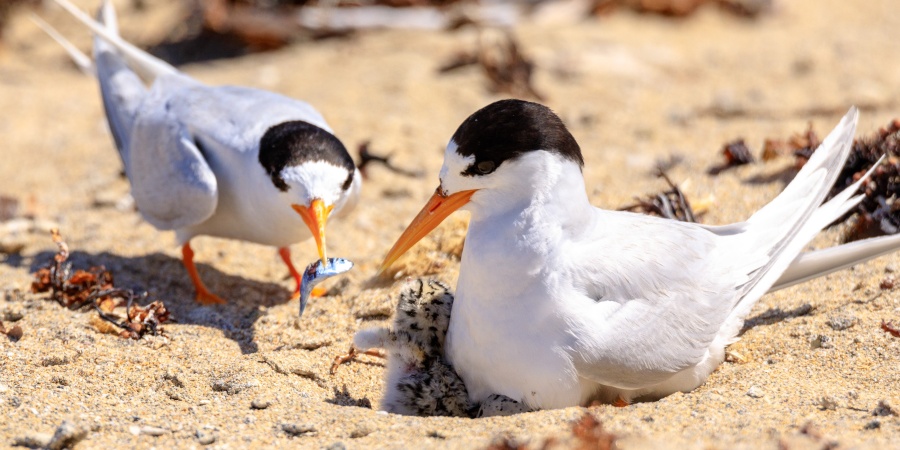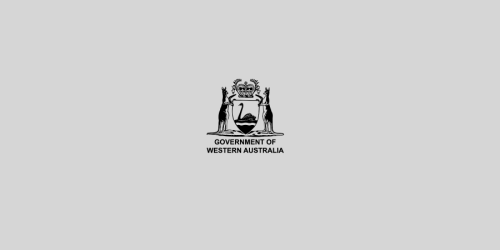
Fairy terns (Photo: Rick Dawson/DBCA)
Nominations for listing (and delisting) of threatened flora, fauna and ecological communities. The Western Australian Threatened Species Scientific Committee (TSSC) and Threatened Ecological Communities Scientific Committee (TECSC) meet at least annually to consider nominations to amend the lists of threatened species and threatened ecological communities.
The public is invited to submit nominations to amend (listing, delisting or category change) to the current threatened species (plants and animals) and ecological communities lists. Nominations may be forwarded at any time to tssc@dbca.wa.gov.au (flora and fauna) or tecsc@dbca.wa.gov.au (ecological communities). Nominations must be received by 1 November in order to be considered by the Committee at their meeting in the following year. Early engagement with Species and Communities Program via these email addresses, prior to the submission of a nomination is recommended.
Nominations are also invited to amend (listing, delisting or category change) for the Priority species (plants and animals) and Priority ecological communities lists. Nominations can be submitted at any time to tssc@dbca.wa.gov.au (flora and fauna) or tecsc@dbca.wa.gov.au (ecological communities). Nomination forms are available from the 'Nomination forms' drop-down below.
Ministerial Guidelines
The Biodiversity Conservation Act 2016 provides a statutory basis for the listing of threatened species, specially protected species, extinct species, threatened ecological communities, collapsed ecological communities, critical habitat and key threatening processes.
While the Act provides the broader criteria for listing the above, the Ministerial Guidelines provide further details on the criteria and procedures that apply.
Ministerial Guideline No. 1 provides more detail on the procedures that can be used by members of the community to nominate a species or ecological community for listing as a threatened species or threatened ecological community.
The listing process
- The public is invited to submit nominations to add, delete, or to change the threat status of species or ecological communities.
- The Threatened Species Scientific Committee (TSSC) and Threatened Ecological Communities Scientific Committee (TECSC) meet to review the nominations and make recommendations to the Minister for Environment.
- The Minister for Environment endorses or rejects the nominations.
- The threatened species and ecological community lists are updated and published in the Western Australia Government Gazette.
- The nomination outcome will be published on the Departments website and the nominator will be notified.
- The threatened species and ecological community lists are made available on the department's threatened plants, threatened animals, and threatened ecological communities webpages.
Nomination forms
The nomination forms for both Species and Ecological Communities are available below.
Nominations currently being considered
The public consultation period for nominations to amend the Threatened Species List is now closed.
At the conclusion of the assessment process, once the Minister’s decision is available, the outcome of the assessment process will be available on the Threatened Species and Communities page.
| Species name | Nomination type | Current status | Proposed status | Region/s |
|---|---|---|---|---|
| Fauna | ||||
Aipysurus fuscus (dusky seasnake) | Listing | Not listed | Endangered A2bc, B1ab(i,ii,iii,iv,v) | Kimberley |
| Chelodina kuchlingi (Kuchling's snake-necked turtle) | Delisting (taxonomic change) | Critically Endangered | No listing | Kimberley |
Idiosoma intermedium (Coolgardie shield-backed trapdoor spider) | Listing (taxonomic revision) | P3 | Endangered B2ab(i,ii,iii) | Wheatbelt, Goldfields |
Orcaella heinsohni (Australian snubfin dolphin) | Change in category (Migratory to Threatened) | Migratory | Vulnerable C1+2a(i) | Kimberley, Pilbara |
Sousa sahulensis (Australian humpback dolphin) | Change in category (Migratory to Threatened) | Migratory | Vulnerable C1+2a(i) | Kimberley, Pilbara |
Sternula albifrons (little tern) | Change in category (Migratory to Threatened) | Migratory | Vulnerable C2a(i) | Swan, Midwest, Pilbara, Kimberley |
| Flora | ||||
Grevillea cooljarloo | Listing | P1 | Endangered B1ab(iii,v)+2ab(iii,v) | Midwest |
Hakea aculeata (column hakea) | Criteria change | Endangered A2c | Endangered B1ab(i,ii,iii,iv,v)+2ab(i,ii,iii,iv,v) | Wheatbelt |
Hibbertia porongorupensis | Listing | P4 | Critically Endangered B1ab(i,ii,iii,iv,v)+2ab(i,ii,iii,iv,v) | South Coast |
| Leucopogon maritimus | Listing | P1 | Endangered B1ab(i,ii,iii,iv,v)+2ab(i,ii,iii,iv,v) | Swan |
Melaleuca agathosmoides | Listing | P1 | P1 (Not eligible for listing) | South Coast |
Thomasia triloba | Listing | P1 | Extinct | Swan |
Verticordia pityrhops (pinelike featherflower) | Change in category (up-listing) | Endangered C2b | Critically Endangered B1ab(iii,v)+2ab(iii,v) | South Coast |
The public consultation period for nominations to amend the Threatened Ecological Communities List is now closed.
At the conclusion of the assessment process, once the Minister’s decision is available, the outcome of the assessment process will be available on the Threatened Species and Communities page.
Scientific committees
The Western Australian Threatened Species Scientific Committee (TSSC) and Threatened Ecological Communities Scientific Committee (TECSC) are appointed by the Minister for Environment, with administrative support provided by the Department of Biodiversity, Conservation and Attractions.
The role of the committees is to:
- provide advice to the Minister on the listing of threatened species, extinct species, threatened ecological communities, collapsed ecological communities, and key threatening processes under the Biodiversity Conservation Act 2016;
- review and make recommendations annually to the Minister on threatened species (plants and animals) and threatened ecological communities;
- allocate the threatened species and ecological communities to IUCN categories of threat, for endorsement by the Minister; and
- provide advice and recommendations to the Director General in respect of research and management needs arising from the reviews of the threatened species and ecological communities lists and threat categories.
The committees meet at least annually to consider any nominations received since the previous meeting.
The Terms of Reference for the TSSC and TECSC, and further details on the committees’ roles are in the download below - Ministerial Guideline 1.
| Member | General area of expertise |
|---|---|
| Dr Ken Atkins | Flora conservation management, environmental legislation application, Commonwealth listing alignment |
| Dr Sarah Barrett | Flora conservation management, fire ecology and disease (dieback) threats |
| Dr Andrew Burbidge | Threatened species, especially vertebrate animals |
| Dr Saul Cowen | Terrestrial vertebrates, especially birds and mammals |
| Dr Rob Davis | Frogs, reptiles and birds |
| Prof Kingsley Dixon | Flora ecology and conservation management. Member CTSSC |
| Ryan Ellis | Threatened species ecology, conservation and management. Reptiles, amphibians and mammals |
| Dr Carl Gosper | Threatening processes on species survival. Vascular flora, mammals, birds and ants |
| Dr Mark Harvey | Arachnids and millipedes, short-range endemic invertebrates |
| Dr Melinda Moir | Terrestrial invertebrates, especially insects |
| Prof Kristin Warren | Birds, mammals and reptiles, animal health |
| Member | General area of expertise |
|---|---|
| Adj/Prof Bill Humphreys | Subterranean fauna, survey and taxonomy. |
| Mr Greg Keighery | Flora and vegetation, biological survey, weeds, vegetation communities’ composition and variation. |
| Ms Vicki Long | Survey and management of Pilbara and Kimberley flora and vegetation. |
| Dr Ben Miller | Plant communities, restoration ecology, and fire science. |
| Mr Andrew Mitchell | Botanical survey and monitoring of Murchison, Gascoyne and Pilbara rangelands; exotic weed identification and eradication. |
| A/Prof Belinda Robson | Ecology, management and restoration of freshwater ecosystems; climate change impacts and ecosystem responses. |
| Prof Stephen van Leeuwen | Biodiversity surveys in WA; Pilbara and western desert flora and fauna. |
| Mr Andrew Webb | Management of flora and vegetation, field botany, environmental impact assessment and management, monitoring and recognition of listed flora and ecological communities. |
| Mr Greg Woodman | Environmental and project management, biological (flora and vegetation) surveys and assessments, rehabilitation techniques and planning, environmental impact assessment. |
Contact details
Email: tssc@dbca.wa.gov.au or tecsc@dbca.wa.gov.au
Mailing address:
Threatened Species Scientific Committee or Threatened Ecological Communities Scientific Committee
Species and Communities Program
Department of Biodiversity, Conservation and Attractions
Locked Bag 104
Bentley Delivery Centre WA 6983
